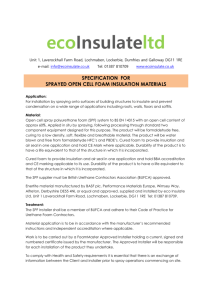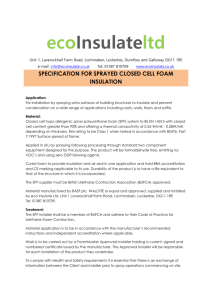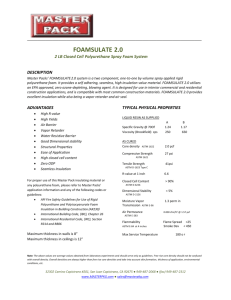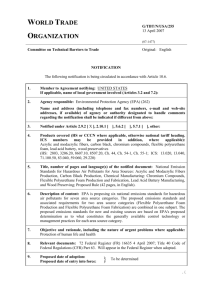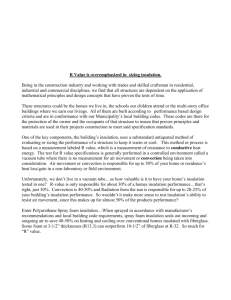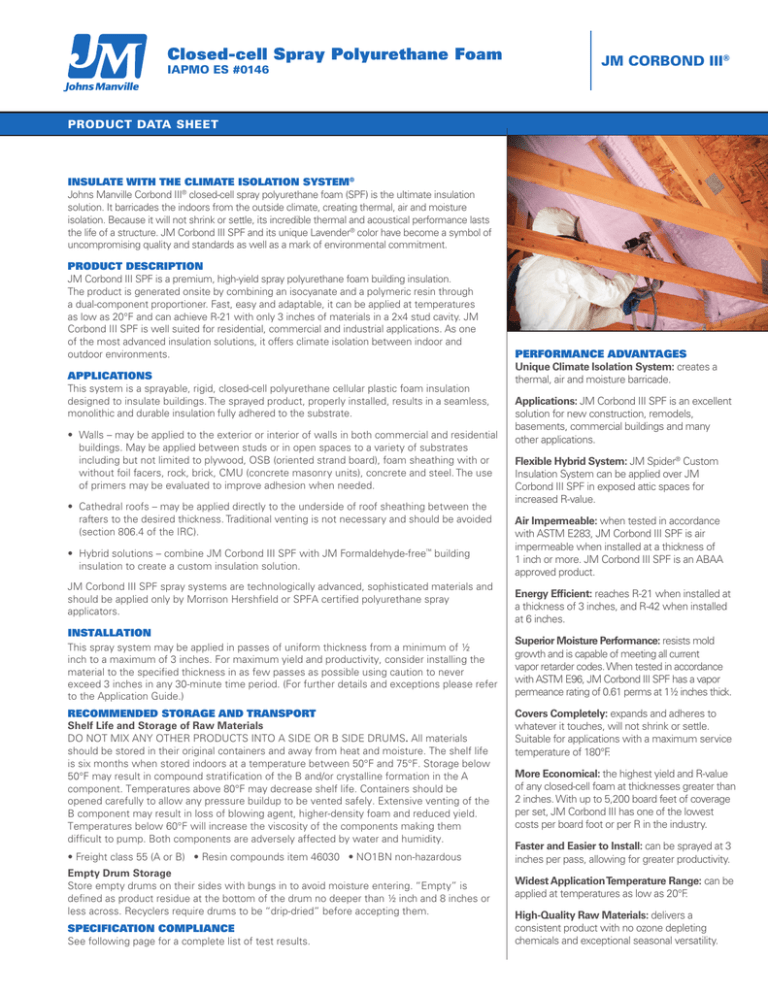
Closed-cell Spray Polyurethane Foam
IAPMO ES #0146
JM CORBOND III®
PRODUCT DATA SHEET
INSULATE WITH THE CLIMATE ISOLATION SYSTEM®
Johns Manville Corbond III® closed-cell spray polyurethane foam (SPF) is the ultimate insulation
solution. It barricades the indoors from the outside climate, creating thermal, air and moisture
isolation. Because it will not shrink or settle, its incredible thermal and acoustical performance lasts
the life of a structure. JM Corbond III SPF and its unique Lavender® color have become a symbol of
uncompromising quality and standards as well as a mark of environmental commitment.
PRODUCT DESCRIPTION
JM Corbond III SPF is a premium, high-yield spray polyurethane foam building insulation.
The product is generated onsite by combining an isocyanate and a polymeric resin through
a dual-component proportioner. Fast, easy and adaptable, it can be applied at temperatures
as low as 20°F and can achieve R-21 with only 3 inches of materials in a 2x4 stud cavity. JM
Corbond III SPF is well suited for residential, commercial and industrial applications. As one
of the most advanced insulation solutions, it offers climate isolation between indoor and
outdoor environments.
APPLICATIONS
This system is a sprayable, rigid, closed-cell polyurethane cellular plastic foam insulation
designed to insulate buildings. The sprayed product, properly installed, results in a seamless,
monolithic and durable insulation fully adhered to the substrate.
• Walls – may be applied to the exterior or interior of walls in both commercial and residential
buildings. May be applied between studs or in open spaces to a variety of substrates
including but not limited to plywood, OSB (oriented strand board), foam sheathing with or
without foil facers, rock, brick, CMU (concrete masonry units), concrete and steel. The use
of primers may be evaluated to improve adhesion when needed.
• Cathedral roofs – may be applied directly to the underside of roof sheathing between the
rafters to the desired thickness. Traditional venting is not necessary and should be avoided
(section 806.4 of the IRC).
• Hybrid solutions – combine JM Corbond III SPF with JM Formaldehyde-free™ building
insulation to create a custom insulation solution.
JM Corbond III SPF spray systems are technologically advanced, sophisticated materials and
should be applied only by Morrison Hershfield or SPFA certified polyurethane spray
applicators.
INSTALLATION
This spray system may be applied in passes of uniform thickness from a minimum of ½
inch to a maximum of 3 inches. For maximum yield and productivity, consider installing the
material to the specified thickness in as few passes as possible using caution to never
exceed 3 inches in any 30-minute time period. (For further details and exceptions please refer
to the Application Guide.)
RECOMMENDED STORAGE AND TRANSPORT
Shelf Life and Storage of Raw Materials
DO NOT MIX ANY OTHER PRODUCTS INTO A SIDE OR B SIDE DRUMS. All materials
should be stored in their original containers and away from heat and moisture. The shelf life
is six months when stored indoors at a temperature between 50°F and 75°F. Storage below
50°F may result in compound stratification of the B and/or crystalline formation in the A
component. Temperatures above 80°F may decrease shelf life. Containers should be
opened carefully to allow any pressure buildup to be vented safely. Extensive venting of the
B component may result in loss of blowing agent, higher-density foam and reduced yield.
Temperatures below 60°F will increase the viscosity of the components making them
difficult to pump. Both components are adversely affected by water and humidity.
PERFORMANCE ADVANTAGES
Unique Climate Isolation System: creates a
thermal, air and moisture barricade.
Applications: JM Corbond III SPF is an excellent
solution for new construction, remodels,
basements, commercial buildings and many
other applications.
Flexible Hybrid System: JM Spider® Custom
Insulation System can be applied over JM
Corbond III SPF in exposed attic spaces for
increased R-value.
Air Impermeable: when tested in accordance
with ASTM E283, JM Corbond III SPF is air
impermeable when installed at a thickness of
1 inch or more. JM Corbond III SPF is an ABAA
approved product.
Energy Efficient: reaches R-21 when installed at
a thickness of 3 inches, and R-42 when installed
at 6 inches.
Superior Moisture Performance: resists mold
growth and is capable of meeting all current
vapor retarder codes. When tested in accordance
with ASTM E96, JM Corbond III SPF has a vapor
permeance rating of 0.61 perms at 1½ inches thick.
Covers Completely: expands and adheres to
whatever it touches, will not shrink or settle.
Suitable for applications with a maximum service
temperature of 180°F.
More Economical: the highest yield and R-value
of any closed-cell foam at thicknesses greater than
2 inches. With up to 5,200 board feet of coverage
per set, JM Corbond III has one of the lowest
costs per board foot or per R in the industry.
• Freight class 55 (A or B) • Resin compounds item 46030 • NO1BN non-hazardous
Faster and Easier to Install: can be sprayed at 3
inches per pass, allowing for greater productivity.
Empty Drum Storage
Store empty drums on their sides with bungs in to avoid moisture entering. “Empty” is
defined as product residue at the bottom of the drum no deeper than ½ inch and 8 inches or
less across. Recyclers require drums to be “drip-dried” before accepting them.
Widest Application Temperature Range: can be
applied at temperatures as low as 20°F.
SPECIFICATION COMPLIANCE
See following page for a complete list of test results.
High-Quality Raw Materials: delivers a
consistent product with no ozone depleting
chemicals and exceptional seasonal versatility.
Closed-cell Spray Polyurethane Foam
IAPMO ES #0146
JM CORBOND III ®
PRODUCT DATA SHEET
SPECIFICATION COMPLIANCE
See below for a complete list of test results.
TYPICAL PHYSICAL PROPERTIES
PROPERTY
Nominal Density
Compressive Strength (1")
Closed-cell Content
Water Absorption
TEST METHOD
ASTM D1622
ASTM D1621
ASTM D6226
(Aged R-Value) 1" thick specimen
ASTM C518 (Aged R-Value) 4” thick specimen
ASTM D2842
Water Vapor Transmission
ASTM E96
Air Infiltration
ASTM E283-04
Air Permeance
ASTM E2178-03
Time to Occupancy
CAN/ULC-S774
R-Value
Sound Transmission Coefficient (STC)
2 x 4 wood stud, 16" on centers,
2.76" of JM Corbond III SPF, 15/32" exterior
OSB sheeting, ½" gypsum wallboard.
Recycled Content of Side B
ASTM E90-90 & ASTM E413-87
JM CORBOND III SPF
2.0 lb/cu ft
36 psi
>90%
7.0
28
0.88%
0.61 perms at 1.5" (Class II Vapor Retarder)
1.1 perms at 1"
75 Pa 0.001 L/S/m²
(1.57 psf) (<0.001cfm/ft²)
300 Pa 0.001 L/S/m²
(6.24 psf) (<0.001 cfm/ft²)
75 Pa 0.000055 L/S.m2.Pa
0.000117 ft³/min.m2.Pa
12 Hours – Trades
24 Hours – Building Occupants
36 (STC)
9% (pre- and post-consumer)
NOTES:
1. This information is intended only as a guide for design purposes. The values shown are obtained from sprayed laboratory samples. The test methods were performed per the test method standards.
2. Thermal performance (K-Factor and R-Value) may vary depending on age and use conditions.
The information herein is to assist customers in determining whether our products are suitable for their applications. We request that customers inspect and test our products before use and satisfy themselves as to content and suitability.
Our products are intended for sale to industrial and commercial customers for processing. Products are manufactured to meet written specifications. Nothing herein shall constitute any other warranty express or implied, including any warranty
of merchantability or fitness, nor is protection from any law or patent to be inferred. The exclusive remedy for all proven claims is replacement of raw materials and in no event shall we be liable for special, incidental or consequential damages.
Closed-cell Spray Polyurethane Foam
IAPMO ES #0146
JM CORBOND III ®
PRODUCT DATA SHEET
PROPERTIES AND PROCESSING CHARACTERISTICS
LIQUID COMPONENT PROPERTIES VISCOSITY
Component A (cps)
250@75ºF
Component B (cps)
650@75ºF
Specific Gravity @ 75°F
A: 1.25 B: 1.21
Mixing Ratio Component A and B
1:1
Minimum
Maximum
Note: This numerical flame spread and all other data presented
are not intended to reflect the hazards presented by this or any
other material in actual fire situations.
The use of polyurethane foam in interior applications on walls
or ceilings presents a fire risk unless protected by an approved
15-minute thermal barrier. One example of an approved
“thermal barrier” is half-inch gypsum wallboard. Consultation
with building code officials before application is recommended.
Caution: Polyurethane foam may present a fire hazard if
exposed to fire or excessive heat (e.g., cutting torches,
soldering torches, etc.). Each firm, person or corporation
engaged in the use, manufacture, production or application
of polyurethane foams should carefully examine construction
sequencing and end-use to determine any potential fire
hazard associated with such product and to utilize appropriate
precautionary and safety measures during construction.
EQUIPMENT
Follow published changeover procedures to prevent crosscontamination that could affect finished foam properties.
Proportioning equipment shall be capable of metering each
component within ±2% of the metering ratio previously noted.
The gun should be of the internal mix type, which provides
thorough blending of the two components. The equipment
shall be of the heated airless type capable of maintaining 160°F
at the gun by use of both primary heaters and heated hoses
The use of 2:1 transfer pumps is recommended for supplying
the liquid components to the proportioner.
PROCESSING CHARACTERISTICS
AND RECOMMENDATIONS
Component A
Component B
Gun Pressure at Tip (dynamic)
WINTER
20°F
70°F
SUMMER
45°F
120°F
For applications below 35°F, JM Corbond III technical personnel
may be consulted. “Flash” passes should be avoided during
cold-weather applications.
Flammability Characteristics
Surface Burning Characteristics: ASTM E84
Flame Spread: <25
Smoke: <450
PREHEATER
95–120°F
105–125°F
min 1,100 psi
RECOMMENDED SUBSTRATE TEMPERATURES AT
TIME OF APPLICATION
HOSE
100–125°F
These temperatures are typical of those required to produce
mixed product using conventional Graco/Gusmer equipment
under various conditions. Environmental conditions may dictate
the use of other temperature ranges. However, under no
circumstances should a temperature of 135°F be exceeded
without first contacting a Johns Manville technical representative.
It is the responsibility of the applicator to determine the specific
temperature settings to match the environmental conditions, his
own equipment and these materials.
SPRAYING
This spray system may be applied in passes of uniform
thickness from a minimum of ½ inch to a maximum of 3 inches.
For maximum yield and productivity, the product may be
applied in a single pass to the specified thickness or up to a 3
inch maximum pass. (Exceptions may exist when sheet metal
or gypsum wallboard substrates are encountered. Consult
Application Guide.) “Flash” passes or a thin pass of less than
1 inch on cold surfaces is to be avoided and may result in loss
of adhesion of subsequent passes and yield. Thicknesses over
3 inches require multiple passes. Allow product curing and
cooling time between each pass, 10 minutes per inch applied;
i.e., 3 inch pass requires minimum 30 minutes. (Hot substrates
may require more time, see Application Guide.) JM Corbond III
SPF must not be applied in a thickness exceeding 3 inches in a
single pass. If this thickness is exceeded, it will adversely affect
the quality and physical properties of the finished product and
the internal temperature building up within the foam may cause
charring or thermal degradation. (Under certain conditions,
applications exceeding this thickness may cause spontaneous
combustion of the foam to occur, even hours after product was
applied.)
CLEANUP LIQUIDS
Nonflammable solvents should be used for cleanup. Consult
your solvent manufacturer MSDS for handling precautions.
PROTECTIVE EQUIPMENT
Spraying of polyurethane foam results in the atomizing of the
components to a fine mist. Inhalation and exposure to the
atomized particles must be avoided.
Applicators must use personal protective equipment
recommended by the Center for Polyurethanes Industry
for use in high pressure spray foam application.
Please visit www.spraypolyurethane.org for additional
information on appropriate PPE selection and use.
Closed-cell Spray Polyurethane Foam
IAPMO ES #0146
JM CORBOND III ®
PRODUCT DATA SHEET
APPLICATION GUIDE
DESCRIPTION
This system is sprayable, rigid, closed-cell polyurethane cellular plastic
foam insulation designed to insulate buildings. The sprayed product,
properly installed, results in a seamless, monolithic and durable insulation
fully adhered to the substrate. JM Corbond III SPF spray systems are
technologically advanced, sophisticated materials and should be applied
only by experienced contractors certified by Morrison Hershfield or SPFA.
WALLS
JM Corbond III SPF may be applied to the exterior or interior of walls in
both commercial and residential buildings. May be applied between studs
or in open spaces to a variety of substrates including but not limited to
plywood, OSB (oriented strand board), foam sheathing with or without foil
facers, rock, brick, CMU (concrete masonry units), concrete and steel. The
use of primers may be evaluated to improve adhesion when needed.
CATHEDRAL ROOFS
JM Corbond III SPF may be applied directly to the underside of roof
sheathing between the rafters to the desired thickness. Traditional venting
is not necessary and should be avoided (section 806.4 of the IRC).
VAPOR RETARDERS
Typically, no additional vapor retarder needs be installed over a cavity
where JM Corbond III SPF has been installed greater than 1½ inches.
JM Corbond III SPF’s low water-vapor permeance and excellent sealing
characteristics allow it to function as its own vapor retarder. (See Physical
Properties.) The elimination of a second vapor retarder will avoid the
creation of what is commonly known as a water vapor “trap.” The use
of JM Corbond III SPF in conjunction with other insulation products or in
special environments such as freezers, swimming pools or other special
environments may require specific technical attention to vapor retarders.
Please consult JM Corbond III SPF technical personnel.
CLEARANCES TO HEAT SOURCES
A minimum of 3 inches of clearance is required between JM Corbond III
SPF and combustion appliance flues, fireplace flues, recessed can lights,
including IC-rated fixtures, heat lamps and other heat-producing sources.
COMBUSTION AIR TO COMBUSTION APPLIANCES
Modern construction techniques of house tightening require that outside
air inlets be provided to deliver combustion air to natural gas, propane or
oil-fired appliances such as furnaces, boilers, water heaters, space heaters,
etc., including gas or wood-burning fireplaces. Backdraft dampers or
positive pressure venting may be needed on combustion appliance vents
to prevent negative air pressures developed by bath or kitchen vent fans
from backdrafting combustion effluent into the building interior.
FIRE, THERMAL BARRIER AND IGNITION BARRIER
WARNING: POLYURETHANE FOAMS WILL BURN WHEN
EXPOSED TO FIRE
The use of polyurethane foam in interior applications on walls or ceilings
may present a fire risk unless protected by an approved 15-minute thermal
barrier. One example of an approved “thermal barrier” is ½ inch gypsum
wallboard. See section 316.4 of the IRC or section 2603.4 of the IBC for
further information on thermal barriers. Alternative solutions to prescribed
thermal barriers are available as tested in accordance with NFPA 286.
Please consult a Johns Manville representative for further information.
Consulting with building code officials before application is recommended.
In attics and crawlspaces that are entered only for service of utilities,
model building codes require covering of foam plastics with an ignition
barrier material such as 1½ inches mineral fiber, ¼ inch wood structural
panel, 3⁄8 inch particle board, ¼ inch hardboard, 3⁄8 inch gypsum wallboard,
0.016 inch galvanized steel (16 gauge), or have specific approval testing in
end-use configuration and maximum thickness intended for use. Further
information can be found in section 316.5.3 and 316.5.4 of the IRC.
Alternative solutions to prescribed ignition barriers are available. Please
consult a Johns Manville representative for further information.
SUBSTRATE PREPARATION
For optimum results, surfaces receiving JM Corbond III SPF should be
clean and dry, free of dirt, oil, solvent, grease, loose particulate, peeling
coating or other foreign matter.
Untreated wood, plywood and oriented strand board (OSB) typically do
not need primer. JM Corbond III SPF also adheres well without primer to
expanded polystyrene, extruded polystyrene, foil-faced insulation boards,
concrete masonry units (CMU) and cured concrete. Ferrometallic substrates
(especially mild steel) may be sand-blasted for increased adhesion in
accordance with SSPC-SP6. Sand-blasted surfaces should be immediately
primed with an epoxymide primer as recommended by the primer
manufacturer. Galvanized and stainless steel, and aluminum substrates may
be treated with an appropriate wash primer or adhesive prior to application
of JM Corbond III SPF. Consult your primer manufacturer and JM for a
specific recommendation. Acid wash or other pre-wash may also be needed.
DRYWALL SUBSTRATES
Drywall substrates to which JM Corbond III SPF is to be applied in
thicknesses greater than 1½ inches require a first pass thickness at and
not to exceed 1½ inches with an appropriate cure time before full
thickness pass is applied. Lift thicknesses exceeding 1½ inches to drywall
may deform the drywall. Drywall requires no priming. Similar precautions
may apply to pre-engineered metal buildings.
SUBSTRATE TEMPERATURE AND MOISTURE
This spray system is provided in different reactivity profiles to meet varying
substrate temperatures as noted in Processing Characteristics. Substrates
over 90ºF, such as decks of cathedral roofs with sunshine above, require
longer than minimum cooling time between passes. Flash passes at cold
substrates are to be avoided. JM Corbond III SPF technical personnel
should be consulted in all cases where application conditions are marginal.
Moisture in the form of rain, dew, frost or other sources can seriously
affect the adhesion of urethane foam to the substrate or to itself. During
application water reacts with the mixed foam components, seriously
affecting the foam’s physical properties.
INDOOR APPLICATION PRECAUTIONS
All personnel in the spray area must be equipped with a fresh-air-supplied
face mask or hood. Applicators must use personal protective equipment
recommended by the Center for Polyurethanes Industry for use in high
pressure spray foam application. Additional precautions include, but are
not limited to:
a. Post warning signs at all work area entrances. (Available from
JM at no charge.)
b. No welding, smoking or open flame.
c. Seal off the work area from adjacent rooms and ventilation ducts.
d. Mask areas required to prevent overspray such as windows, doors,
tubs and showers, etc.
e. Restrict access of nonapplication personnel.
f. Provide ventilation as needed.
g. Provide breathing and eye protection to both workers and spectators.
OUTDOOR APPLICATION PRECAUTIONS
All personnel in the spray area must be equipped with a fresh-air-supplied
face mask or hood. Applicators must use personal protective equipment
recommended by the Center for Polyurethanes Industry for use in high
pressure spray foam application. The area surrounding the spray operation
should be protected from overspray and exposure of individuals not involved
in the spray operations. Additional precautions include, but are not limited to:
a. Post warning signs a minimum of 100 feet from all work areas.
b. No welding, smoking or open flame.
c. Close all air-intake vents on air-handling equipment on the building.
d. Provide breathing and eye protection for spectators.
e. Move vehicles out of area.
f. Do not apply when the wind velocity is greater than 10 mph to avoid
overspraying of perimeter areas.
CLIMATIC CONDITIONS
Cold temperatures and high wind speeds retard the exothermic reaction
of foam and can lead to poor adhesion, increased density and loss of yield,
as well as thermal shock. Avoid moisture in the form of rain, dew, frost or
other sources, which can seriously affect the adhesion of JM Corbond III
SPF to the substrate or to itself.
Closed-cell Spray Polyurethane Foam
IAPMO ES #0146
JM CORBOND III ®
PRODUCT DATA SHEET
PROCESS SAFETY, HEALTH AND TOXICITY INFORMATION
Safety Data Sheets on product components and the finished product are
available from JM. Installers of this product should read and understand
the SDS before use.
PROTECTIVE EQUIPMENT
Spraying of polyurethane foam results in the atomizing of the components
to a fine mist. Inhalation and exposure to the atomized droplets must
be avoided. Applicators must use personal protective equipment
recommended by the Center for Polyurethanes Industry for use in high
pressure spray foam application. Precautions include, but are not limited to:
a. Full-face mask or hood with fresh air source
b. Fabric coveralls
c. Non-permeable gloves
d. Solvent-resistant gloves when handling new materials and
cleaning solvents.
WARNING: Exposure may occur even when no noticeable odor
is encountered.
PHYSICAL EXAMINATIONS OF PERSONNEL
All personnel to be employed in the spraying of these materials should
have a complete physical examination prior to employment. Periodic
checkups are recommended if the personnel continue to spray these
materials. Personnel with the following conditions should avoid the
spraying of these components:
a. Asthma or chronic bronchitis
b. Chronic respiratory disorders
c. Sensitization to chemical substances including polymeric isocyanates
DERMAL EXPOSURE
If a major splash or spill of the raw material (A) or (B) component comes
in contact with the skin, the affected area should immediately be washed
with generous amounts of water from a safety shower or other water
source. Contaminated clothing should be removed and the skin wiped
with a clean dry cloth to remove residual material. The affected area should
then be wiped with a 70% solution of rubbing alcohol (isopropol) followed
by repeated washing with soap and water. If a rash develops, a physician
should be consulted immediately.
EYE EXPOSURE
Splashes of either component into the eyes should be flushed immediately
with generous amounts of water for at least 15 minutes. CONSULT
TRAINED MEDICAL PERSONNEL IMMEDIATELY.
INHALATION
Symptoms of vapor inhalation are characterized by coughing, tightness
in the chest and shortness of breath. Excessive exposure can produce
serious, possibly irreversible lung damage. Smoking in the area of
application increases the risk of pulmonary injury and must be prohibited.
High concentrations of isocyanate may cause symptoms and problems to
appear immediately. However, chronic exposure may also lead to the same
symptoms and problems. IF BREATHING HAS STOPPED, ARTIFICIAL
RESPIRATION MUST BE PROMPTLY APPLIED.
If breathing is short, oxygen (if available) should be administered by trained
medical personnel. OBTAIN MEDICAL ATTENTION IMMEDIATELY.
APPLICATORS
See the A&B component SDS for more complete raw material
handling information.
CLEANUP
Nonflammable solvents should be used for cleanup. Consult your solvent
manufacturer for handling precautions.
INCOMPATIBLE MATERIALS
The isocyanate component (A) is incompatible with strong bases,
tertiary amines or water. These materials may cause rapid, spontaneous
polymerization with subsequent generation of heat and gas.
DECONTAMINATION OF SPILLS
In the event of a major isocyanate (A) spill, the area should be immediately
evacuated. Only personnel equipped with appropriate respiratory and eye
protection equipment should remain. If the spill occurs indoors, the area
should be ventilated and leaking containers should be taken outdoors and
the remaining isocyanate transferred to other containers.
The spill should be covered with sawdust, ekoperl, vermiculite, fuller’s
earth or other oil-absorbing material and should then be treated with a
dilute solution of ammonium hydroxide/detergent. The neutralized material
should be swept up and placed in a suitable container. The material should
then be disposed of by a standard method consistent with good industrial
practice and in accordance with environmental protection regulations in
your area. Where permissible, sanitary landfill disposal is recommended.
Visit our website at www.JM.com or call 800-654-3103 | 717 17th Street Denver, CO 80202
Technical specifications as shown in this literature are intended to be used as general guidelines only. The physical and chemical properties of
JM Corbond III® SPF listed herein represent typical, average values obtained in accordance with accepted test methods and are subject to normal
manufacturing variations. They are supplied as a technical service and are subject to change without notice. Any references to numerical flame spread
or smoke developed ratings are not intended to reflect hazards presented by these or any other materials under actual fire conditions. Check with the
sales office nearest you for current information. All Johns Manville products are sold subject to Johns Manville’s Limited Warranty and Limitation
of Remedy. For a copy of the Johns Manville Limited Warranty and Limitation of Remedy or for information on other Johns Manville thermal and
acoustical insulation and systems, call or write to the 800 number or address listed above.
BID-0110 2/16
© 2016 Johns Manville. All Rights Reserved.

